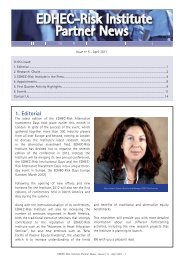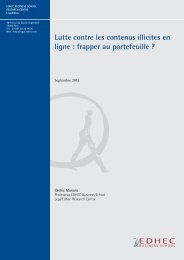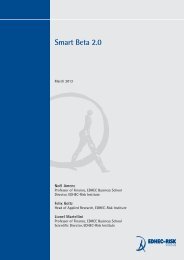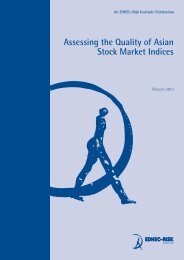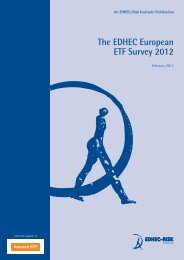The Smart Beta 2.0 Approach - EDHEC-Risk
The Smart Beta 2.0 Approach - EDHEC-Risk
The Smart Beta 2.0 Approach - EDHEC-Risk
Create successful ePaper yourself
Turn your PDF publications into a flip-book with our unique Google optimized e-Paper software.
An ERI Scientific <strong>Beta</strong> Publication — <strong>Smart</strong> <strong>Beta</strong> <strong>2.0</strong> — April 2013<br />
Copyright © 2013 ERI Scientific <strong>Beta</strong>. All rights reserved. Please refer to the disclaimer at the end of this document.<br />
23<br />
2. Controlling the <strong>Risk</strong>s of <strong>Smart</strong> <strong>Beta</strong> Investing:<br />
<strong>The</strong> <strong>Smart</strong> <strong>Beta</strong> <strong>2.0</strong> <strong>Approach</strong><br />
<strong>The</strong> first approach to take into account the systematic risks of investing in <strong>Smart</strong> <strong>Beta</strong> that we feel is<br />
very compatible with the idea that an index must remain a simple construction is the disentangling<br />
of the two ingredients that form the basis of any <strong>Smart</strong> <strong>Beta</strong> index construction scheme: the stock<br />
selection and weighting phases.<br />
A very clear separation of the selection and weighting phases enables investors to choose the<br />
risks to which they do or do not wish to be exposed. This choice of risk is expressed firstly by a<br />
very specific and controlled definition of the investment universe. An investor wishing to avail of a<br />
better diversified benchmark than a cap-weighted index but disinclined to take on liquidity risk can<br />
decide to apply this scheme solely to a very liquid selection of stocks. In the same way, an investor<br />
who does not want the diversification of his benchmark to lead him to favour stocks with a value<br />
bias can absolutely decide that the diversification method chosen will only be applied to growth,<br />
or at least not strictly value, stocks, etc.<br />
In an article published recently in the Journal of Portfolio Management (Amenc, Goltz and Lodh,<br />
2012) we have been able to show that the distinction between the selection and weighting phases<br />
(which can be made for most <strong>Smart</strong> <strong>Beta</strong> construction methods) could add value both in terms<br />
of performance and in controlling the investment risks. Exhibits 9 and 10 reproduce some of the<br />
results in the article.<br />
Exhibit 9: Size exposure of diversification strategies based on different size-based stock selections – <strong>The</strong> table shows the excess (over S&P 500) risk<br />
factor exposures of the Global Minimum Volatility, Maximum Sharpe Ratio, and Maximum Decorrelation portfolios based on broad S&P 500 stock<br />
universe and three size based stock selections. <strong>The</strong> stock selection is done at each rebalancing. Weekly return data from 5 July 1963 to 31 December<br />
2010 obtained from CRSP is used for the analysis. We run the following regressions to identify factor exposures<br />
(2)<br />
(3)<br />
R P is the time series of test portfolio returns, R CW is the S&P 500 time series returns, β M is the market beta, β S is the size (big-small) beta, R S is the size<br />
factor which is the return of a portfolio (cap-weighted) long in 1/5th largest cap stocks and short in 1/5th smallest cap stocks that constitute the<br />
NYSE, AMEX and NASDAQ universe, and Res is the residual time series from equation 3 regression. This two-step process is used for each risk factor<br />
and for each test portfolio. <strong>The</strong> bold values indicate that the beta for the size factor tilt is significant at 1% confidence level. All averages reported are<br />
geometric averages and all statistics are annualised.<br />
Global Minimum Volatility (GMV) Maximum Sharpe Ratio (MSR) Maximum Decorrelation (MDC)<br />
Universe<br />
All stocks<br />
Small size<br />
universe<br />
Medium size<br />
universe<br />
Large size<br />
universe<br />
All stocks<br />
Small size<br />
universe<br />
Medium size<br />
universe<br />
Large size<br />
universe<br />
All stocks<br />
Small size<br />
universe<br />
Medium size<br />
universe<br />
Large size<br />
universe<br />
Market exposure of<br />
excess returns over CW<br />
-26.20%<br />
-25.41%<br />
-28.03%<br />
-23.92%<br />
-21.92%<br />
-23.69%<br />
-23.94%<br />
-20.09%<br />
-8.60%<br />
-7.93%<br />
-10.57%<br />
-6.59%<br />
Size (Big - Small)<br />
exposure of excess<br />
returns over CW<br />
-19.00%<br />
-43.75%<br />
-19.32%<br />
1.83%<br />
-21.13%<br />
-46.28%<br />
-21.40%<br />
0.29%<br />
-37.07%<br />
-65.59%<br />
-27.26%<br />
-3.15%<br />
<strong>The</strong> results show that the three optimised strategies 18 included in the analysis all have significant<br />
implicit small-cap exposure relative to the S&P 500 index when no stock selection is made.<br />
18 - GMV (Global Minimum Variance) portfolios aim to minimise portfolio volatility. GMV optimization is performed in the presence of norm constraints<br />
(DeMiguel, Garlappi, Nogales and Uppal, 2009) with a lower bound of N/3 on the effective number where N is the total number of stocks in the relevant<br />
universe. MSR (Maximum Sharpe Ratio) optimization aims to maximise the Sharpe Ratio of the portfolio. <strong>The</strong> downside risk of stocks are used as a proxy<br />
for their expected returns (Amenc, Goltz, Martellini and Retkowsky, 2011) and the covariance matrix is obtained using principal component analysis. MDC<br />
(Maximum Decorrelation) optimization is an approach which exploits low correlations across stocks to reduce portfolio risk rather than concentrating in<br />
low volatility stocks, which is a limit often underlined with GMV approaches. <strong>The</strong> MDC approach aims to minimise portfolio volatility under the assumption<br />
that volatility across all stocks is identical (Christoffersen et al., 2010), hence focusing on exploiting differences in correlations rather than on exploiting<br />
differences in volatility across stocks.




